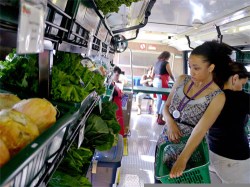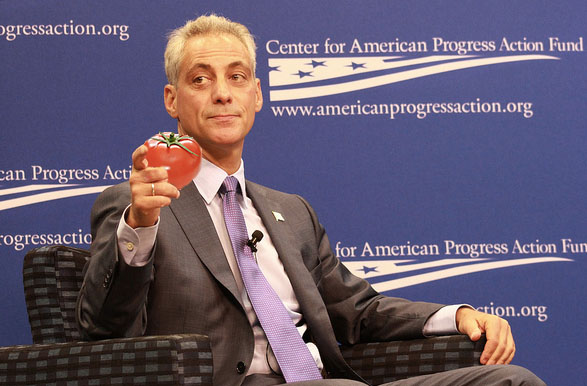
Talk Radio News ServiceThey’re carrots! They’re f*&^ing good for you!
Not many people would see value in a retired Chicago Transit Authority bus with 500,000 miles on the odometer, a slow engine, and seats bursting at the seams. But in late 2011, a group of Chicagoans looking for a way to transport groceries into their deprived neighborhood had a vision. They bought the bus for $1, and with grant money, made repairs, tore out the seats, and gave it a fresh paint job and a fitting new name: Fresh Moves.
Today, Fresh Moves, a nonprofit serving the city’s south and west sides, has two buses in its fleet, with a third coming in June. When growing season arrives, the crates onboard overflow with locally grown fruits and vegetables. And the lines of residents awaiting its arrival grow longer and longer.
If Mayor Rahm Emanuel has his way, services such as Fresh Moves will soon take root and flourish citywide under a completely revamped food system designed to change the way Chicagoans eat. Emanuel’s recently adopted, $5.8 million Recipe for Healthy Places is a comprehensive agenda seeking to curtail obesity by changing Chicago’s food culture. His goal: to make fresh food affordable and available within a mile of every resident’s home. And why not? This is, after all, home of The Bean.
But Emanuel has his work cut out for him: Of the city’s 2.8 million inhabitants, 400,000 live in food deserts — neighborhoods clogged with fast food chains but devoid of grocery stores. And Chicagoans’ favorite dishes aren’t exactly right out of The Enchanted Broccoli Forest. This is the city of deep-dish pizza and unfortunate prophetic menu offerings like spicy chicken “thunder thighs.” Since 1980, obesity in Chicago has doubled among adults and tripled among children.

The Fresh Moves buses bring locally grown produce to city neighborhoods.
Other cities have similar programs: New York has FoodWorks, Minneapolis has Home Grown Minneapolis, and Los Angeles has Good Food For All. But what sets Chicago’s plan apart is its comprehensive approach, says Bradley Roback, the city’s sustainable development coordinator, who helped draft the agenda. Two years in the making, the multi-department, citizen-driven plan incorporated input gathered at 24 meetings throughout the city from more than 400 residents — from community and backyard gardeners to urban farmers, nutritionists, and nonprofiteers.
The plan has of six major goals: build healthier neighborhoods, grow more food, expand healthy food enterprises, strengthen the food “safety net” (stock soup kitchens and food pantries with healthy choices and allow residents to food stamps at more places that sell good food), serve healthy food and beverages, and improve the overall eating habits of Windy City residents. So precise is it that it even addresses getting more hospitals and clinics to promote breastfeeding, getting healthy food into children at birth.
Much of the plan is already underway through the mayor’s overall Healthy Places agenda. Vacant city lots are being converted to neighborhood gardens and an urban farming district is growing on the city’s blighted south and west sides, part of an overarching Green Healthy Neighborhoods initiative. Dozens of asphalt school lots have been dug up and converted to gardens. The city has invested $68,000 to put fresh fruit and vegetable carts on neighborhood streets, with each vendor running his own small business.
Coming soon: More local farmers markets, and several national grocery chains have committed to opening stores in underserved neighborhoods. Smaller corner stores are being encouraged to carry fresh produce. There are new guidelines for social service agencies serving shelters and food pantries, soup kitchens, and churches. Food offerings at city festivals and concerts will be reviewed. Even sporting events are targeted. (Oh, die, thy beloved, holy, Chicago-style hot dog! Served with celery salt, mustard, never katsup, always on a poppy-seed bun …)
And this is just the first breaths of the mayor’s vision. Planners say their road map is “organic” (badum-bum) and will grow and change with education and access to healthier choices.
But changing how Chicagoans eat will take time. Take, for example, the people who work for the city itself. Much to city workers’ dismay, an estimated 300 vending machines in municipal buildings will be cleared of chips and danishes and stocked instead with apples, oranges, and low-fat snacks. In City Hall, some of the machines have already disappeared, replaced by a sign that reads, “New, Improved Vending Options Coming.”
Just as well, says one worker. “You end up spending $1.50 a day on Flamin’ Hot Cheetos because you’re hungry and you have to get away from your desk. Not only is it bad for you, it’s expensive. Over the course of a year, that could be a flat screen TV.”
Or a new bicycle! Right guys? Right?
While an apple may not initially taste as scrumptious as thunder chicken thighs, with some education and given a choice, people will choose the apple — or so the mayor believes. And if they have no choice other than a healthy option, they will take it. Even better if it was grown right down the block.
With time, maybe Chicago will live up to its given Latin motto: Urbs in Horto. Translation: City in a garden.



